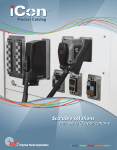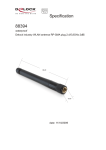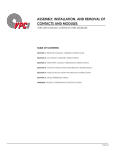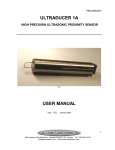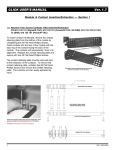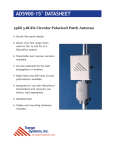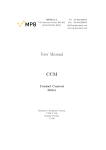Download Micro Coaxial User Manual - Equip-Test
Transcript
ASSEMBLY, INSTALLATION, AND REMOVAL OF CONTACTS AND MODULES FOR MICRO COAXIAL CONTACTS AND MODULES TABLE OF CONTENTS SECTION 1 RECEIVER CONTACT ASSEMBLY INSTRUCTIONS SECTION 2 ITA CONTACT ASSEMBLY INSTRUCTIONS SECTION 3 CONTACT INSTALLATION AND REMOVAL INSTRUCTIONS SECTION 4 MODULE INSTALLATION AND REMOVAL INSTRUCTIONS SECTION 5 CROSS REFERENCE TABLES SECTION 6 PRODUCT PERFORMANCE SPECIFICATIONS 2/19/10 VIRGINIA PANEL CORPORATION MICRO COAXIAL CONTACTS AND MODULES USER’S MANUAL: SECTION 1 MICRO COAXIAL RECEIVER CONTACT ASSEMBLY 50 OHM • PART # 610 140 101 FOR RG 316, PART # 610 140 102 FOR RG 178 75 OHM • PART # 610 140 103 FOR RG 179 TOOLS REQUIRED Soldering Fixture, Part # 910 121 178 Hex Crimp Tool Kit, Part # 910 101 131 for RG178 • 910 101 132 for RG179/316 Contains: Crimper, Locator, Part # 910 101 135, and .050” Allen Wrench Inspection Depth Gauge, Part # 910 121 179 Dimensions shown: [millimeters] ASSEMBLY INSTRUCTIONS BRAID Figure A. Strip outer insulation to dimension shown. BRAID 3. Strip wire center conductor (Figure C). FERRULE 4. Solder wire center conductor into contact center conductor, and clean (Figure D). NOTE: Contact center conductor and dielectric must touch (Figure E). 5. Calibrate the Inspection Depth Gauge, Part # 910 121 179 (Figure F), by loosening the dial face retaining screw until the dial face allows itself to be turned. Insert the calibration plug into base of gauge. While keeping constant pressure on the plug, adjust the dial by rotating it such that the pointer points to “0”. Re-tighten retaining screw. Adjust locating markers to “8” and “97”. Continued on next page... [5.1] 0.20 OUTER INSULATION 1. Strip the outer insulation of the wire (Figure A). 2. Slide the ferrule onto the wire and fold braid back over ferrule (Figure B). Comb braid and make sure that it covers 50-100% of the smaller portion of the ferrule but does not reach past the shoulder. inches DIELECTRIC NO BRAID PAST SHOULDER Figure B. Slide ferrule onto wire. [1.5] 0.06 WIRE CENTER CONDUCTOR Figure C. Strip wire center conductor to dimension shown. CONTACT CENTER CONDUCTOR FERRULE WIRE BRAID SOLDER FIXTURE Figure D. Soldering Fixture, Part # 910 121 178. DIELECTRIC SOLDER NO GAP PERMISSIBLE CONTACT CENTER CONDUCTOR Figure E. Ensure contact center conductor and dielectric touch. Figure F. Inspection Depth Gauge, Part # 910 121 179. 1-1 For more information visit vpc.com 2/19/10 MICRO COAXIAL CONTACTS AND MODULES USER’S MANUAL: SECTION 1 VIRGINIA PANEL CORPORATION MICRO COAXIAL RECEIVER CONTACT ASSEMBLY 50 OHM • PART # 610 140 101 FOR RG 316, PART # 610 140 102 FOR RG 178 75 OHM • PART # 610 140 103 FOR RG 179 ASSEMBLY INSTRUCTIONS, CONTINUED 6. Slide shield conductor over center conductor until the shield conductor stops flush (Figure G). NOTE: Do not twist the shield conductor; twisting will cause the braid to bunch. MAINTAIN FLUSH WITH FERRULE SHIELD CONDUCTOR Figure G. Shield conductor must be flush with ferrule. 7. Check the flush +.003″/ -.008″ dimension (Figure H) by using the inspection depth gauge. Insert contact into gauge until contact stops. If pointer measures between “8” and “97”, go to step 8. If the pointer is out of the range of the two markers, slide the ferrule to adjust. Repeat steps 1-7 if necessary. 8. Before using the Hex Crimp Tool (Figure J), you must install the locator (Figure K). Remove the 2 screws using the .050” Allen wrench and replace the existing locator with the Locator, Part # 910 101 135 (Figure L). Tighten the 2 screws. The tool is now ready to crimp receiver contacts. 9. Crimp using the Hex Crimp Tool in larger opening for RG 316 and RG 179, or smaller opening for RG 178. To ensure proper crimp position, press shield conductor flush inside the locator (Figure M). OBSERVE PRECISION RATCHET ACTION BY OPENING AND CLOSING CRIMP TOOL FULLY SEVERAL TIMES. THE TOOL CANNOT BE OPENED WITHOUT COMPLETING A CYCLE. NEVER ATTEMPT TO DISASSEMBLE TOOL. NEVER TIGHTEN OR LOOSEN STOP NUTS ON BACK OF TOOL. Wire must not be allowed to pull on the center conductor during crimping (for example, long wire hanging down to floor). Ensure outer shield is flush with ferrule after crimping (Figure N). [0.07] .003 [0.20] .008 Figure H. Flush dimensions. Figure J. Hex Crimp Tool Kit, Part # 910 101 131 for RG178 • 910 101 132 for RG179/316. Figure K. Locator, Part # 910 101 135. Figure L. Locator in die assembly. 9. Use the inspection depth gauge to verify the flush +.003″/ -.008″ dimension as shown in step 7. If the dimension is out of range, repeat steps 1-10. LOCATOR Figure M. Contact with locator. HEX CRIMP AREA MAINTAIN FLUSH WITH FERRULE Figure N. Final assembly. 1-2 For more information visit vpc.com 2/19/10 VIRGINIA PANEL CORPORATION MICRO COAXIAL CONTACTS AND MODULES USER’S MANUAL: SECTION 1 MICRO COAXIAL RECEIVER CONTACT ASSEMBLY 50 OHM • PART # 610 140 104 FOR RG 316DS Dimensions shown: [millimeters] inches [10.67] .42 OUTER INSULATION TOOLS REQUIRED Soldering Fixture, Part # 910 121 178 Inspection Depth Gauge, Part # 910 121 179 BRAID Figure A. Strip outer insulation to dimension shown. ASSEMBLY INSTRUCTIONS [6.35] .25 1. Strip the outer insulation of the wire (Figure A) and tin the braid. 2. Perform second strip (Figure B). 0.17” will be trimmed from the front of the wire to remove any solder build up. [2.29] .09 [1.52] .06 [4.32] .17 WIRE CENTER CONDUCTOR DIELECTRIC Figure B. Second strip will remove any solder build-up. 3. Solder wire center conductor into contact center conductor, and clean (Figure C). NOTE: Contact center conductor and dielectric must touch (Figure D). 4. Calibrate the Inspection Depth Gauge, Part # 910 121 179 (Figure E), by loosening the dial face retaining screw until the dial face allows itself to be turned. Insert the calibration plug into base of gauge. While keeping constant pressure on the plug, adjust the dial by rotating it such that the pointer points to “0”. Re-tighten retaining screw. Adjust locating markers to “8” and “97”. 5. Slide the shield conductor over the center conductor and check the flush +.003″/ -.008″ dimension (Figure F) by using the inspection depth gauge. Insert contact into gauge until contact stops. If the pointer measures between “8” and “97”, go to the next step. If the pointer measures below the “97” marker, slide the shield to adjust. If the dimension measures above the “8” marker, cut the strip off and repeat steps 1-5. 6. Solder the shield and clean (Figure G). NOTE: Make sure the shield does not move when soldering. CONTACT CENTER CONDUCTOR WIRE BRAID SOLDER FIXTURE Figure C. Soldering Fixture, Part # 910 121 178. NO GAP PERMISSIBLE DIELECTRIC CONTACT CENTER CONDUCTOR SOLDER Figure D. Ensure contact center conductor and dielectric touch. 7. Use the inspection depth gauge to verify the flush +.003″/ -.008″ dimension as shown in step 5. If the dimension is out of range, repeat steps 1-7. Figure E. Inspection Depth Gauge, Part # 910 121 179. [0.07] .003 [0.20] .008 Figure F. Flush dimensions. SHIELD CONDUCTOR Figure G. Assemble shield conductor. 1-3 For more information visit vpc.com 2/19/10 VIRGINIA PANEL CORPORATION MICRO COAXIAL CONTACTS AND MODULES USER’S MANUAL: SECTION 2 MICRO COAXIAL ITA CONTACT ASSEMBLY 50 OHM • PART # 610 141 101 FOR RG 316, PART # 610 141 102 FOR RG 178 75 OHM • PART # 610 141 103 FOR RG 179 TOOLS REQUIRED Soldering Fixture, Part # 910 121 178 Hex Crimp Tool Kit, Part # 910 101 131 for RG178 • 910 101 132 for RG179/316 Contains: Crimper, Locator, Part # 910 101 139, and .050” Allen Wrench Inspection Depth Gauge, Part # 910 121 180 Dimensions shown: [millimeters] ASSEMBLY INSTRUCTIONS inches 1. Strip the outer insulation of the wire (Figure A). [5.1] 0.20 OUTER INSULATION 2. Slide the ferrule onto the wire until it stops on outer insulation and fold braid back over the ferrule (Figure B). Comb braid and make sure that it covers 50-100% of the smaller portion of the ferrule but does not reach past the shoulder. BRAID Figure A. Strip outer insulation to dimension shown. BRAID 3. Strip center conductor (Figure C). 4. Solder wire center conductor into contact center conductor and clean (Figure D). NOTE: Contact center conductor and dielectric must touch (Figure E). 5. Calibrate the Inspection Depth Gauge, Part # 910 121 180 (Figure F), by loosening the dial face retaining screw until the dial face allows itself to be turned. Insert the calibration plug into base of gauge. While keeping constant pressure on the plug, adjust the dial by rotating it such that the pointer points to “0”. Re-tighten retaining screw. Adjust locating markers to “5” and “95”. DIELECTRIC NO BRAID PAST SHOULDER FERRULE Figure B. Slide ferrule onto wire. [1.5] 0.06 WIRE CENTER CONDUCTOR Figure C. Strip wire center conductor to dimension shown. CONTACT CENTER CONDUCTOR Continued on next page... BRAID WIRE FERRULE SOLDER FIXTURE Figure D. Soldering Fixture, Part # 910 121 178. DIELECTRIC SOLDER NO GAP PERMISSIBLE CONTACT CENTER CONDUCTOR Figure E. Ensure contact center conductor and dielectric touch. Figure F. Inspection Depth Gauge, Part # 910 121 180. 2-1 For more information visit vpc.com 2/19/10 VIRGINIA PANEL CORPORATION MICRO COAXIAL CONTACTS AND MODULES USER’S MANUAL: SECTION 2 MICRO COAXIAL ITA CONTACT ASSEMBLY 50 OHM • PART # 610 141 101 FOR RG 316, PART # 610 141 102 FOR RG 178 75 OHM • PART # 610 141 103 FOR RG 179 ASSEMBLY INSTRUCTIONS, CONTINUED 6. Slide shield conductor over center conductor until the shield conductor stops flush (Figure G). NOTE: Do not twist the shield conductor; twisting will cause the braid to bunch. 7. Check the .136″ ± .005 dimension (Figure H) by using the inspection depth gauge. Insert contact into gauge until contact stops. If pointer measures between “5” and “95”, go to step 8. If the pointer is out of the range of the two markers, slide the ferrule to adjust. Repeat steps 1-7, if necessary. 8. Before using the Hex Crimp Tool (Figure J), you must install the locator (Figure K). Remove the 2 screws using the .050” Allen wrench and replace the existing locator with the Locator, Part # 910 101 139 (Figure L). Tighten the 2 screws. The tool is now ready to crimp ITA contacts. 9. Crimp using the Hex Crimp Tool (Figure J) in larger opening for RG 316 and RG 179, or smaller opening for RG 178. To ensure proper crimp position, slide shield conductor over pin on the locator (Figure M). OBSERVE PRECISION RATCHET ACTION BY OPENING AND CLOSING CRIMP TOOL FULLY SEVERAL TIMES. THE TOOL CANNOT BE OPENED WITHOUT COMPLETING A CYCLE. NEVER ATTEMPT TO DISASSEMBLE TOOL. NEVER TIGHTEN OR LOOSEN STOP NUTS ON BACK OF TOOL. SHIELD CONDUCTOR MAINTAIN FLUSH WITH FERRULE Figure G. Shield conductor must be flush with ferrule. [3.45±0.13] .136±.005 Figure H. Flush dimensions. Figure J. Crimp Tool, Part # 910 101 131 for RG178 • 910 101 132 for RG179/316. Figure K. Locator, Part # 910 101 139. Wire must not be allowed to pull on the center conductor during crimping (for example, long wire hanging down to floor). Ensure outer shield is flush with ferrule after crimping (Figure N). 10. Use the inspection depth gauge to verify the .136″ ± .005 dimension as shown in step 7. If the dimension is out of range, repeat steps 1-10. Figure L. Locator in die assembly. Figure M. Contact with crimp tool locator. HEX CRIMP AREA MAINTAIN FLUSH WITH FERRULE Figure N. Final assembly. 2-2 For more information visit vpc.com 2/19/10 VIRGINIA PANEL CORPORATION MICRO COAXIAL CONTACTS AND MODULES USER’S MANUAL: SECTION 2 MICRO COAXIAL ITA CONTACT ASSEMBLY 50 OHM • PART # 610 141 104 FOR RG 316DS Dimensions shown: [millimeters] TOOLS REQUIRED Soldering Fixture, Part # 910 121 178 Inspection Depth Gauge, Part # 910 121 180 inches [10.67] .42 OUTER INSULATION BRAID Figure A. Strip outer insulation to dimension shown. ASSEMBLY INSTRUCTIONS [6.35] .25 1. Strip the outer insulation of the wire (Figure A) and tin the braid. 2. Perform second strip (Figure B). 0.17” will be trimmed from the front of the wire to remove any solder build up. 3. Solder wire center conductor into contact center conductor, and clean (Figure C). NOTE: Contact center conductor and dielectric must touch (Figure D). 4. Calibrate the Inspection Depth Gauge, Part # 910 121 180 (Figure E), by loosening the dial face retaining screw until the dial face allows itself to be turned. Insert the calibration plug into base of gauge. While keeping constant pressure on the plug, adjust the dial by rotating it such that the pointer points to “0”. Re-tighten retaining screw. Adjust locating markers to “5” and “95”. 5. Slide the shield conductor over the center conductor and check the .136″ ± .005 dimension (Figure F) by using the inspection depth gauge. Insert contact into gauge until contact stops. If the pointer measures between “5” and “95”, go to the next step. If the pointer measures below the “95” marker, slide the shield to adjust. If the dimension measures above the “5” marker, cut the strip off and repeat steps 1-5. DIELECTRIC [2.29] .09 [1.52] .06 [4.32] .17 WIRE CENTER CONDUCTOR Figure B. Second strip will remove any solder build-up. CONTACT CENTER CONDUCTOR WIRE BRAID SOLDER FIXTURE Figure C. Soldering Fixture, Part # 910 121 178. NO GAP PERMISSIBLE DIELECTRIC CONTACT CENTER CONDUCTOR SOLDER Figure D. Ensure contact center conductor and dielectric touch. 6. Solder the shield and clean (Figure G). 7. Use the inspection depth gauge to verify the .136″ ± .005 dimension as shown in step 5. If the dimension is out of range, repeat steps 1-7. Figure E. Inspection Depth Gauge, Part # 910 121 180. [3.45±0.13] .136±.005 Figure F. Flush dimensions. SHIELD CONDUCTOR Figure G. Assemble shield conductor. 2-3 For more information visit vpc.com 2/19/10 MICRO COAXIAL CONTACTS AND MODULES USER’S MANUAL: SECTION 3 VIRGINIA PANEL CORPORATION MICRO COAXIAL RECEIVER CONTACT INSTALLATION AND REMOVAL PART # 610 140 101 / 610 140 102 / 610 140 103 / 610 140 104 TOOLS REQUIRED .050” Allen Wrench Micro Coax Receiver/ITA Extraction Tool, Part # 910 112 123 CONTACT INSTALLATION INSTRUCTIONS 1. Assemble the contact to the respective wire. NOTE: For more information concerning the contact assembly process, see contact assembly instructions in Section 1 of this User’s Manual. 2. Insert the terminated contact into the back of the assembled module. The contact can only go into one side. Once in place, pull the wire slightly to ensure that the contact is seated. CONTACT REMOVAL INSTRUCTIONS 1. Remove the module from the receiver frame. NOTE: For more information concerning the process of removing the module from the receiver frame, see module installation and removal instructions in Section 4 of this User’s Manual. 2. Use a .050” Allen wrench to remove the two 0-80 screws located at the top and bottom of the module. (Phillips head screwdriver for iCon modules.) 3. Grasp the module halves and apply force in opposite directions, rocking the ends of the module while slightly pulling the module cap away from the mating bottom section, until separated. Be sure to open both sides of the module simultaneously or contacts could be damaged. 4. Place the Micro Coax Receiver/ITA Extraction Tool (Figure A) over the contact to be removed/replaced. Use care to keep the tool perpendicular to the surface of the module, otherwise the tool or contact could be damaged. 5. Once the extraction tool is seated and the retaining tabs on the retaining ring are compressed (Figure B), push the plunger. The contact will be pushed out of the rear of the module. Figure A. Ensure that the tool is kept perpendicular to the module face to avoid damage to the contact or tool. DO NOT DEPRESS THE PLUNGER ON THE BACK OF THE EXTRACTION TOOL UNTIL THE TIP OF THE EXTRACTION TOOL HAS FULLY SEATED INTO THE MODULE AND COMPRESSED THE RETAINING RING TABS ON THE CONTACT. OTHERWISE THE RETAINING RING COULD BE DAMAGED. 6. Replace the module cap using both hands to push the separated halves together. Replace and tighten the module cap screws to a maximum torque of 0.875 in-lbs [0.23 Nm]. NOTE: The process shown here uses standard/90 series modules. The same process is used for modules from other series. NOTE: If you are using a hybrid module, you may need to reference the User’s Manual for the other contact type for extraction instructions. 3-1 Figure B. Push the plunger only after the retaining tabs are compressed. For more information visit vpc.com 2/19/10 MICRO COAXIAL CONTACTS AND MODULES USER’S MANUAL: SECTION 3 VIRGINIA PANEL CORPORATION MICRO COAXIAL ITA CONTACT INSTALLATION AND REMOVAL PART # 610 141 101 / 610 141 102 / 610 141 103 / 610 141 104 TOOLS REQUIRED Micro Coax Receiver/ITA Extraction Tool, Part # 910 112 123 CONTACT INSTALLATION INSTRUCTIONS 1. Assemble the contact to the respective wire. NOTE: For more information concerning the contact assembly process, see contact assembly instructions in Section 2 of this User’s Manual. 2. Insert the assembled contact into the back of the module. Push the contact forward until the crimp is inside the module housing. Once in place, pull the wire slightly to ensure the contact is seated. CONTACT REMOVAL INSTRUCTIONS 1. Remove the module from the ITA frame. NOTE: For more information concerning the process of removing the module from the ITA frame, see module installation and removal instructions in Section 4 of this User’s Manual. 2. Place the Micro Coax Receiver/ITA Extraction Tool (Figure A) over the contact to be removed/replaced. Use care to keep the tool perpendicular to the surface of the module as not to bend the tool or the contact to be removed. Rotate the tool slightly while pushing it into the counter bore on the mating side of the module. 3. Figure A. Ensure that the tool is kept perpendicular to the module face to avoid damage to the contact or tool. Once the extraction tool is seated properly and the tabs on the retaining ring are compressed (Figure B), push the plunger. The contact will be pushed out of the rear of the module. DO NOT DEPRESS THE PLUNGER ON THE BACK OF THE EXTRACTION TOOL UNTIL THE TIP OF THE EXTRACTION TOOL HAS BEEN FULLY SEATED INTO THE MODULE AND COMPRESSED THE RETAINING RING TABS ON THE CONTACT, OTHERWISE THE RETAINING RING COULD BE DAMAGED. NOTE: The process shown here uses standard/90 series modules. The same process is used for modules from other series. NOTE: If you are using a hybrid module, you may need to reference the User’s Manual for the other contact type for extraction instructions. 3-2 Figure B. Push the plunger only after the retaining tabs are compressed. For more information visit vpc.com 2/19/10 MICRO COAXIAL CONTACTS AND MODULES USER’S MANUAL: SECTION 4 VIRGINIA PANEL CORPORATION MICRO COAXIAL STANDARD/90 SERIES MODULE INSTALLATION AND REMOVAL TOOLS REQUIRED 3 /32 Allen Wrench INSTALLATION INSTRUCTIONS 1. Place the module in the receiver or ITA until the upper and lower module screws touch the mating holes in the inner frame. Ensure that Position 1 is located at the top for systems in which the modules are oriented vertically or to the left for systems in which the modules are oriented horizontally. 2. Using a 3/32 Allen wrench, tighten the top screw 1 to 2 full revolutions, while pushing lightly against the face of the module. 3. Maintain this pressure while tightening the bottom screw 1 to 2 full revolutions. 4. Repeat this sequence until the module is seated. Torque the screw to 4 in-lbs [0.45 Nm]. POSITION 1 REMOVAL INSTRUCTIONS 1. To remove, loosen the top screw 1 to 2 full revolutions. Loosen bottom screw 1 to 2 full revolutions. 2. Repeat this sequence until the module is separated from the receiver or ITA. Figure A. Receiver Module. NOTE: Push or pull the module evenly from the top and bottom to prevent damage to the module. NOTE: For optimum performance and system longevity, distribute the contact load evenly throughout the module. Figure B. ITA Module. 4-1 For more information visit vpc.com 2/19/10 MICRO COAXIAL CONTACTS AND MODULES USER’S MANUAL: SECTION 4 VIRGINIA PANEL CORPORATION MICRO COAXIAL ICON MODULE INSTALLATION AND REMOVAL TOOLS REQUIRED Phillips Head Screwdriver INSTALLATION INSTRUCTIONS NOTE: The receiver strain relief plate or the ITA cover may need to be removed prior to installing or removing an iCon module. Please refer to the appropriate User’s Manual for instructions on how to perform these steps. 1. Place the module in the receiver or ITA until the upper and lower module screws touch the mating holes in the inner frame. Install modules such that Position 1 is located at the top of the ITA/receiver frame. 2. Using a Phillips head screwdriver, tighten the top screw 1 to 2 full revolutions, while pushing lightly against the face of the module. 3. Maintain this pressure while tightening the bottom screw 1 to 2 full revolutions. 4. Repeat this sequence until the module is seated. Torque the screw to 1.5 in-lbs [0.17 Nm]. Figure A. Receiver Module. REMOVAL INSTRUCTIONS 1. To remove, loosen the top screw 1 to 2 full revolutions. Loosen bottom screw 1 to 2 full revolutions. 2. Repeat this sequence until the module is separated from the receiver or ITA. NOTE: Push or pull the module evenly from the top and bottom to prevent damage to the module. NOTE: For optimum performance and system longevity, distribute the contact load evenly throughout the module. Figure B. ITA Module. 4-2 For more information visit vpc.com 2/19/10 5-1 X 610 141 102 X X X X X 610 141 103 X X X X X 610 141 104 X X X X X X X X X X 610 140 102 X X X X X X 610 140 103 X X X X X X 610 140 104 X X X X X X EXTRACTION 910 112 123 910 121 178 910 121 180 X X X X X X X X X X X X X X X X X EXTRACTION 910 112 123 910 121 178 910 121 179 X X X X X X X X X X X X X X X X For more information visit vpc.com MISC. LOCATOR CRIMP TOOLS ICON RECEIVER MODULES STANDARD/ 90 SERIES RECEIVER MODULES 910 101 135 X 910 101 132 X MISC. LOCATOR 910 101 139 X 910 101 132 CRIMP TOOLS 910 101 131 X ICON ITA MODULES 510 160 112 X 610 140 101 910 101 131 X 510 160 111 510 161 111 X 510 160 107 510 161 107 X 510 160 106 510 161 106 610 141 101 510 104 270 STANDARD/ 90 SERIES ITA MODULES RECEIVER CONTACTS 510 104 267 510 108 263 ITA CONTACTS 510 108 262 MICRO COAXIAL CONTACTS AND MODULES USER’S MANUAL: SECTION 5 VIRGINIA PANEL CORPORATION CROSS REFERENCE TABLES 2/19/10 VIRGINIA PANEL CORPORATION MICRO COAXIAL CONTACTS AND MODULES USER’S MANUAL: SECTION 6 MICRO COAXIAL CONTACT ELECTRICAL SPECIFICATIONS [21.54] 0.848 [19.30] 0.76 [3.63] 0.143 [2.49] 0.098 Receiver Contact Part # 610 140 101 610 140 102 610 140 103 ITA Contact Part # 610 141 101 610 141 102 610 141 103 Dimensions shown: [millimeters] inches ELECTRICAL SPECIFICATIONS IMPEDANCE 50 Ohm for RG316 or RG178/ 75 Ohm for RG179 FREQUENCY RANGE DC - 3 GHz for RG316 or RG178/ DC-1 GHz for RG179 DIELECTRIC BREAKDOWN 800 VRMS Micro 1.22 Coax@Rf Response 3 GHz VSWR 50 ohm impedance INSERTION LOSS .06 x √f(GHz) db 610 140 101/ 610 141 101: RG316 610 140 102/ 610 141 102: RG178 610 140 103/ 610 141 103: RG179 db INSERTION LOSS dB Insertion Loss RECOMMENDED TERMINATION Micro Coax Rf Response 50 ohm impedance 0 -0.2 0.05 0.54 1.03 1.52 2.02 2.51 3.00 2.02 2.51 3.00 Frequency GHz 1.300 VSWR Ratio VSWR RATIO 1.200 1.100 1.000 0.05 0.54 1.03 1.52 Frequency GHz MECHANICAL CHARACTERISTICS LIFE EXPECTANCY (CYCLES) 10,000 MATING FORCE 1.5 lbs max [0.68 kg] EXTRACTION FORCE 1.5 lbs max [0.68 kg] OUTER SHIELD (ITA) Brass per ASTM - B-16 / .000050” Au over .000100” Ni OUTER SHIELD (RCVR) Brass per ASTM - B-16 / .000050” Au over .000100” Ni CENTER CONDUCTOR (ITA) BeCu per ASTM - B-196 / .000050” Au over .000100” Ni CENTER CONDUCTOR (RCVR) BeCu per ASTM - B-196 / .000050” Au over .000100” Ni RETAINING RING BeCu per ASTM - B-196 / .000100” Ni FERRULE Brass per ASTM - B-16 / .000010” Au over .000100” Cu DIELECTRIC PTFE Fluorocarbon MATERIAL 6-1 For more information visit vpc.com 2/19/10 VIRGINIA PANEL CORPORATION MICRO COAXIAL CONTACTS AND MODULES USER’S MANUAL: SECTION 6 MICRO COAXIAL DOUBLE SHIELDED CONTACT ELECTRICAL SPECIFICATIONS 21.23 .84 3.30 .13 21.51 .85 2.49 .098 Receiver Contact Part # 610 140 104 ITA Contact Part # 610 141 104 Dimensions shown: [millimeters] inches ELECTRICAL SPECIFICATIONS IMPEDANCE 50 Ohm for RG316DS FREQUENCY RANGE DC - 10.5 GHz DIELECTRIC BREAKDOWN 800 VRMS VSWR 1.0225 + .05 f(GHz) INSERTION LOSS .06 x √f(GHz) db RECOMMENDED TERMINATION RG316DS db INSERTION LOSS VSWR RATIO MECHANICAL CHARACTERISTICS LIFE EXPECTANCY (CYCLES) 10,000 MATING FORCE 1.5 lbs max [0.68 kg] EXTRACTION FORCE 1.5 lbs max [0.68 kg] OUTER SHIELD (ITA) Brass per ASTM - B-16 / .000050” Au over .000100” Ni OUTER SHIELD (RCVR) Brass per ASTM - B-16 / .000050” Au over .000100” Ni CENTER CONDUCTOR (ITA) BeCu per ASTM - B-196 / .000050” Au over .000100” Ni CENTER CONDUCTOR (RCVR) BeCu per ASTM - B-196 / .000050” Au over .000100” Ni RETAINING RING BeCu per ASTM - B-196 / .000100” Ni FERRULE Brass per ASTM - B-16 / .000010” Au over .000100” Cu DIELECTRIC PTFE Fluorocarbon MATERIAL 6-2 For more information visit vpc.com 2/19/10















